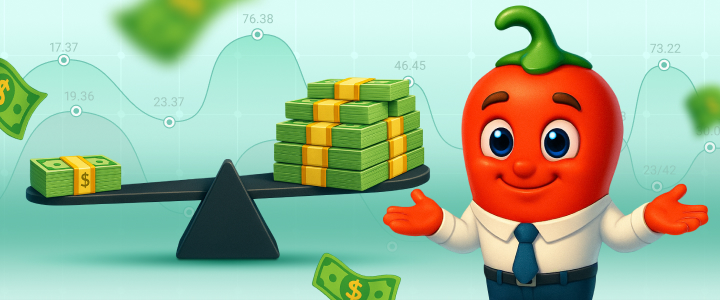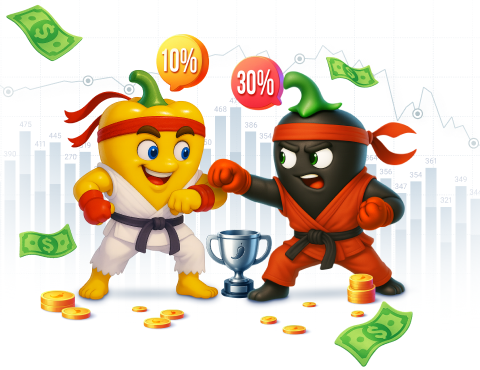Capital Management Methods for High Leverage Trading
07.08.2025
Formazione
Capital management methods have interested mankind for a long time. In Ancient Babylon, there was a 10.0% rule. This is the share of income that was recommended to be directed to risky investments in order to get rich.

The main difference is leverage. It has become an integral part of trading. Leverage has pushed financial mathematics forward. However, a single theory for trading has not yet been formed. There are disparate ideas. From them, everyone forms their own understanding.
When talking about capital management in trading, they usually throw everything into one heap. Myrtingale, fixed volume, anti-martingale, proportional method, averaging, pyramiding.
At first glance, everything is correct. All these words almost always appear in articles on capital management. But this is not the best approach. The task of capital management is to design an ideal ladder for us. Where each step will say at what amount and what volume to trade.
Everything else should rather be attributed to trading strategies. Doubling a position according to Martingale. Or vice versa, reducing it. Averaging a loss. Adding to a profitable position. All these are strategies for managing an already open position. But not for determining the initial volume.
Ryan Jones was the first to express such ideas. They were liked by the record-holder of trading - Larry Williams. He supported them. Now you can read about the ideas in Jones's 1999 book "Stock Market Game: Make a Million Playing with Numbers".
Despite the humorous title, the content of the book is serious. In it, he identified 2 main methods of capital management. And also formulated his approach. According to Ryan Jones, there are fixed fraction methods. This is when the trader initially determines the ratio. For example, 1 lot for every $10,000 of the deposit.
And there are proportional methods. When the risk per transaction is determined immediately. For example, 1.0% of the deposit. And with this risk, the trader calculates the volume of the transaction. John L. Kelly's formula is built into this method. Ralph Vince adapted it for trading. If the deposit is $10,000, the stop loss in the transaction is 40 points, with a point value of $10.0. Then, the appropriate transaction volume will be 0.25 lots. This will give 1.0% of $10,000.
If everything is so simple, why reinvent the wheel. Ryan Jones noticed the shortcomings of each of the methods. In the fixed fraction, he did not like the preservation of risk as the account grows. And the huge period of time before the volume can be increased. If 1 lot for $10,000. And 2 lots for $20,000. Before the volume grows, you need to double the capital. Now it is all easier. It is possible to split lots. Trade mini-contracts. But in 1999, everything was more complicated.
In the proportional method, Jones found only one big drawback. He called it the "reverse leverage effect." If you lose 10.0% of the deposit in a deal. To get it back, you need to earn 11.1%.
To improve the results, Ryan Jones needed to cross both methods. The result was a fixed-proportional one. His idea is in the steps. Each has space before the volume grows or decreases.
For example, if the initial deposit is $10,000, and the trader sets the step at $4000. Then he will receive an increase in the volume to two contracts for $14,000. $10,000 + (1 contract X for $4,000). Three contracts will be included for $22,000. $14,000 + (2 contracts X for $4,000). And so on.
You can lay down the risk through the "step". The smaller it is, the higher the risk. And vice versa. But in the case of an unprofitable transaction, the reverse leverage effect will not be included immediately. The capital will remain at the same level, even if it grows or falls.

4 thousand years have passed. The 10.0% rule is still relevant. It is promoted by financial gurus. But thanks to the development of technology, there are more opportunities. Trading has taken over the world. And it requires its own capital management methods.
The main difference is leverage. It has become an integral part of trading. Leverage has pushed financial mathematics forward. However, a single theory for trading has not yet been formed. There are disparate ideas. From them, everyone forms their own understanding.
Ideas
When talking about capital management in trading, they usually throw everything into one heap. Myrtingale, fixed volume, anti-martingale, proportional method, averaging, pyramiding.
At first glance, everything is correct. All these words almost always appear in articles on capital management. But this is not the best approach. The task of capital management is to design an ideal ladder for us. Where each step will say at what amount and what volume to trade.
Everything else should rather be attributed to trading strategies. Doubling a position according to Martingale. Or vice versa, reducing it. Averaging a loss. Adding to a profitable position. All these are strategies for managing an already open position. But not for determining the initial volume.
Comparison
Ryan Jones was the first to express such ideas. They were liked by the record-holder of trading - Larry Williams. He supported them. Now you can read about the ideas in Jones's 1999 book "Stock Market Game: Make a Million Playing with Numbers".
Despite the humorous title, the content of the book is serious. In it, he identified 2 main methods of capital management. And also formulated his approach. According to Ryan Jones, there are fixed fraction methods. This is when the trader initially determines the ratio. For example, 1 lot for every $10,000 of the deposit.
And there are proportional methods. When the risk per transaction is determined immediately. For example, 1.0% of the deposit. And with this risk, the trader calculates the volume of the transaction. John L. Kelly's formula is built into this method. Ralph Vince adapted it for trading. If the deposit is $10,000, the stop loss in the transaction is 40 points, with a point value of $10.0. Then, the appropriate transaction volume will be 0.25 lots. This will give 1.0% of $10,000.
Ryan Jones' Method
If everything is so simple, why reinvent the wheel. Ryan Jones noticed the shortcomings of each of the methods. In the fixed fraction, he did not like the preservation of risk as the account grows. And the huge period of time before the volume can be increased. If 1 lot for $10,000. And 2 lots for $20,000. Before the volume grows, you need to double the capital. Now it is all easier. It is possible to split lots. Trade mini-contracts. But in 1999, everything was more complicated.
In the proportional method, Jones found only one big drawback. He called it the "reverse leverage effect." If you lose 10.0% of the deposit in a deal. To get it back, you need to earn 11.1%.
To improve the results, Ryan Jones needed to cross both methods. The result was a fixed-proportional one. His idea is in the steps. Each has space before the volume grows or decreases.
For example, if the initial deposit is $10,000, and the trader sets the step at $4000. Then he will receive an increase in the volume to two contracts for $14,000. $10,000 + (1 contract X for $4,000). Three contracts will be included for $22,000. $14,000 + (2 contracts X for $4,000). And so on.
You can lay down the risk through the "step". The smaller it is, the higher the risk. And vice versa. But in the case of an unprofitable transaction, the reverse leverage effect will not be included immediately. The capital will remain at the same level, even if it grows or falls.
And starting from the second step, each step will be safer. At the second step, $7,000 is accounted for in the calculations for each contract. And at the third step it is already $7,333. At the fourth it will be $8,500. And so on. As a result, the growth of the deposit will exert less psychological pressure.
Conclusion
Each trader uses his own method of capital management. With some adjustments, both the fixed fraction and the proportional method can be set up. The main thing is that each professional strictly adheres to his own rules.
Popular articles
Notizie
Formazione
Notizie
Formazione
Notizie
Formazione
Formazione
Notizie
Feedbacks
Formazione
Formazione
Formazione
Notizie
Notizie
Formazione
Notizie
Notizie
Formazione
Notizie
Feedbacks
Feedbacks
Formazione
Notizie
Formazione
What is Prop Trading and How Does it Work?
29.05.2025
Notizie
Feedbacks
Formazione
Forex vs. Gioco d’azzardo
22.05.2025
Notizie
Feedbacks
Formazione
Formazione
Notizie
Formazione
Notizie
Feedbacks
Formazione
Come analizzare il tuo report di trading?
24.04.2025
Feedbacks
Formazione
Notizie
Notizie
Notizie
Formazione
Notizie
Feedbacks
Notizie
Feedbacks
Feedbacks
Notizie
Feedbacks
Notizie
Ottieni doppi reset e conti extra gratis!
14.03.2025
Feedbacks
Notizie
Feedbacks
Notizie
Feedbacks
Feedbacks
Feedbacks
Notizie
Festeggia il capodanno cinese con SpiceProp
05.02.2025
Notizie
Notizie
Notizie
Feedbacks
Feedbacks
Notizie
Notizie
Notizie
Notizie
Notizie
Colloquio
Feedbacks
Notizie
Notizie
Notizie
Feedbacks
Feedbacks
Notizie
Notizie
Notizie
Notizie
Notizie
Formazione
Finanziamento immediato – Come funziona?
03.09.2024
Formazione
Feedbacks
Colloquio
Feedbacks
Formazione
Notizie
Notizie
Formazione
Il lavoro di un prop trader – Come iniziare?
29.07.2024
Feedbacks
Colloquio
Formazione
Feedbacks
Formazione
Come diventare un Prop Trader?
10.07.2024
Notizie
Formazione
Affrontare il rischio e come gestirlo
03.07.2024
Notizie
Notizie
Notizie
Notizie
Feedbacks
Notizie
Feedbacks
Notizie
Notizie
Colloquio
SpiceProp a Invest Cuffs 2024. TV Aziendale
04.05.2024
Formazione
Introduzione all'analisi fondamentale
06.01.2024
Formazione
Le cinque regole di un trader di successo
30.12.2023
Formazione
Come domare le tue emozioni nel trading
12.12.2023
Formazione
Come costruire una strategia di trading
11.12.2023
Formazione
Che cos'è prop trading?
11.12.2023
